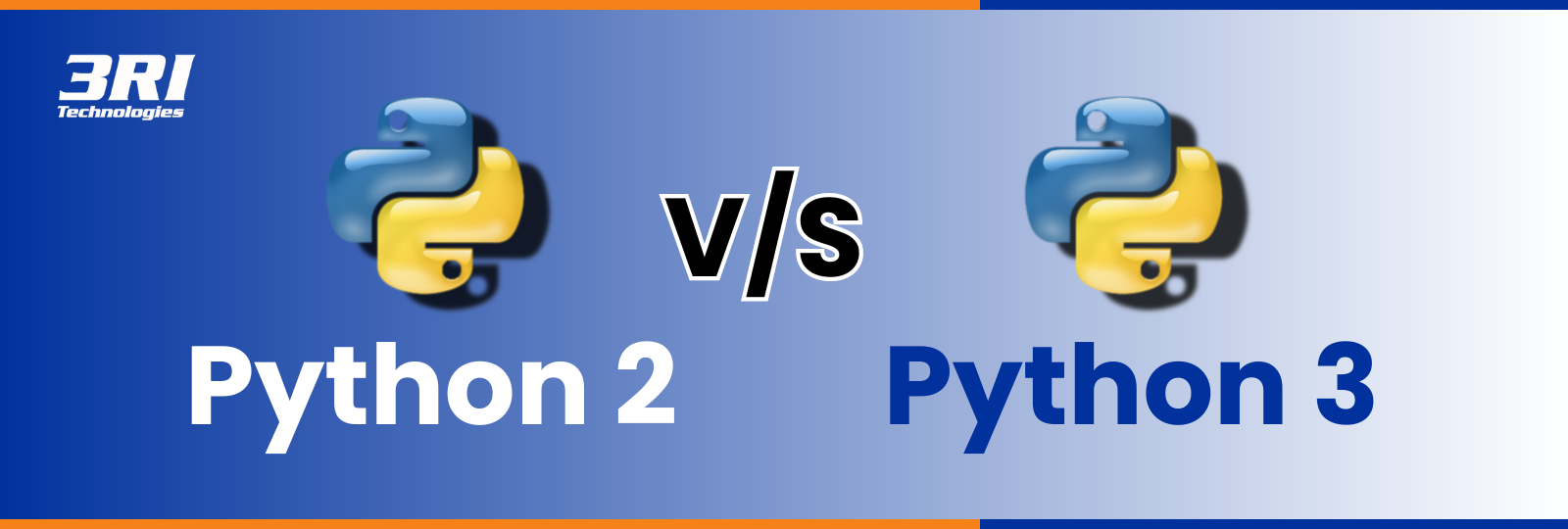Most likely, if you’re considering getting into data science, you’ve heard of Python. Python is a general-purpose, open-source programming language that finds extensive use in data science and other software fields, such as blockchain, online and game development, cybersecurity, and other areas.
In the past few years, Python has become very famous. Several lists of the most popular computer languages, like the TIOBE Index and the PYPL Index, put it at the top.An piece with more information about how Python can be used can be found here.
Python is often rated as one of the easiest computer languages for beginners because its syntax is so simple and easy to understand. One of the most important options if you’re new to data science and not sure which language to learn initially is Python. By enrolling in 3RI Technologies’ Data Scientist with Python career track, you can get started on your data science path right away.
However, things can become unclear. You might also be familiar with Python 3 and 2. This is what? There is only one Python programming language, right? Which one ought you to study? By now, you will always use Python 3, barring any exceptional circumstances, so don’t worry about it. It’s helpful to know the difference in either case.
The critical distinctions between Python 2 and 3 and which is better to learn and use will be covered in the following parts.Eager to stay competitive in your career? Check out the Python Training in Pune.

Python : What Is It?
Python is an object-oriented programming language that can be interpreted highly and features built-in data structures, dynamic binding, and dynamic typing. In case any of these phrases are foreign to you, allow me to explain them to you:
High-level: Python is a high-level programming language. This means that programmers don’t have to remember how the system works or how to handle memory.
Interpreted: With an interpreted language, you can use a third-party interpreting programme to run your code line by line without having to create it beforehand.
This time-saving function makes debugging and testing your code easier.
Object-oriented: With object-oriented programming, the structure of software is organised around objects that hold code and data instead of reasoning and functions.
There are many features in Python that make it easy for people to learn. Python is a simple computer language with a short syntax that can be used for many things. The source code for the language is also freely available, which means that it can be improved upon and altered by anyone. Python is used in a lot of different systems and fields.
Python can be used for various tasks, including constructing software and websites, automation, artificial intelligence, data analysis and visualization, machine learning, and even routine tasks like creating to-do lists and alarms. This programming language comes with a sizable number of libraries, modules, and frameworks, which increases the language’s usefulness while also making the process of coding and developing projects more streamlined.

Want Free Career Counseling?
Just fill in your details, and one of our expert will call you !
Python 2 : What Is It?
Guido van Rossum was the one who initially developed Python in the late 1980s, and he released it to the public for the first time in 1991. Python 2.0 was first made available to the people in 2000, following nine years of development and rising popularity.
Python 2 comes packaged with an all-new technical documentation called the Python Enhancement Proposal (PEP). This document’s purpose was to provide programmers with recommendations and recommendations for how to write Python code. In addition to this, it has brand-new features such as list comprehension, support for Unicode, and a garbage collector that can detect cycles.
However, the most significant alteration that was made in Python 2 was the development process itself.Python is a type of general-purpose computer language that is meant to be easy for beginners to understand. To accomplish this objective, the group of people responsible for developing Python, led by Guido van Rossum, concluded that the development process needed to become more open and receive support from the community.
Python 2 has kept getting better over time. The programming language evolved, gaining new capabilities with each subsequent edition. Python 2.7 was the most recent version of Python 2, published in 2010. On January 1, 2020, support was terminated for this software version. Explore further with our Python Web Development Course to deepen your knowledge and skills.
Python 3 : What Is It?
The programming language has now advanced to the third generation with Python 3. It was made available to the public in December 2008, alongside several alterations and additions.
Python 3 was not simply an updated version of the code for Python 2 that had been debugged. To address safety concerns and deficiencies in the earlier versions’ designs, the new version made significant changes to the language. Python 3 introduced a new syntax to prevent redundant or repetitive code, which can be defined as code that does the same purpose in various ways. Python 3’s readability and convenience of use have been significantly enhanced because of the introduction of a unified, unambiguous approach to completing tasks.
Python 3 introduces several significant enhancements, the most notable of which are converting the print declaration into a built-in function, enhanced integer division, and enhanced support for Unicode. As a result of how these changes were implemented, Python 3 is not compatible with Python 2, or, to put it another way, it is not backward compatible.

Get Free Career Counseling from Experts !
What Is Python’s Purpose?
Python is often used for developing software and websites, analysing data, and making it easier to see. Many non-programmers, including scientists and accountants, have embraced Python due to its ease of learning, and they use it for a range of daily chores, including arranging finances.
“You can write programmes for a variety of purposes, such as earning a living, having fun, helping someone else solve a problem, or solving a challenging data analysis problem.”
What uses does Python allow for? Among the things are:
- Analysis of data and machine learning
- Web programming
- Robotics or scripting
- Testing and prototyping software
- Everyday duties
Here is a closer look at a few typical applications of Python.
- Analysis of Data and Machine Learning
Python has emerged as a critical language in data science, enabling experts to perform intricate statistical computations, generate data visualizations, construct machine learning algorithms, work with and analyze data, and accomplish other data-related tasks.
Python is capable of producing a wide range of data visualisations, such as line and bar graphs, pie charts, 3D plots, and histograms. Additionally, Python offers a wealth of libraries, such as TensorFlow and Keras, that help programmers develop machine learning and data analysis applications more rapidly and effectively.
2. Web Development
Python is commonly used to build the behind-the-scenes components of a website or app.Python is used for a lot of different things in web development, such as moving data between computers, processing data, talking to databases, routing URLs, and keeping things safe.
Python can be used with a number of different web platforms. A lot of people use Django and Flask as models.
Python is utilised regularly in a variety of web development roles, including but not limited to the following: back-end engineers, full-stack engineers, Python developers, software engineers, and DevOps engineers.
Looking forward to becoming a Python Developer? Then get certified with Python Online Training
3. Automation or Scripting
Python automation makes work more efficient when you do a task more than once.Scripting is the process of writing the code that makes these automatic processes possible. Automation can be used in the field of coding to perform simple calculations, check for problems in many files, transform files, and eliminate data duplication.
Even absolute novices can use Python to automate basic computer operations like file renaming, locating and downloading content from the internet, or scheduling the sending of SMS or emails at predetermined times.
4. Software Testing & Prototyping
Build control, issue tracking, and testing are all areas in which Python can be helpful during software development. Thanks to Python, Software developers can now automate testing for new goods or features. There are Python tools like Green and Requestium that can be used to test apps.
5. Routine Tasks
Programmers and data scientists are just some people who can use Python. People who work in professions with less focus on data, such as journalists, owners of small businesses, or social media marketers, may find that learning Python enables them to access new opportunities. Python is not just for programmers; it may also help non-programmers simplify certain aspects of their daily life. Python allows you to automate a wide variety of processes, some of which are listed below:
- Send yourself a text message to bring an umbrella whenever it rains.
- Refresh your supply list.
- Renaming vast quantities of files
- Text file to spreadsheet conversion
- Randomly delegate domestic responsibilities to family members.
- Automate online form completion
6. Software Development
Python has many uses in data science but is also used at every stage of software development, such as for build control, automatic continuous compilation, prototyping, tracking bugs, testing, and maintaining software.
Flexible and powerful at the same time, this programming language can be used to make multi-protocol applications that are either very easy or very complex or applications that do a lot of math.
You can use Python to make music or video programs that use AI or ML, APIs (application programming interfaces), GUIs (graphical user interfaces), or any other software.

Do you want to book a FREE Demo Session?
7. Data Analytics
Python is the programming language behind many of today’s most widely used data mining and analytics technologies .And because of this, it is a great tool for the area of data science. Python gives developers tools that help them tell the difference between important and useful info. The analysis of large amounts of data can not only assist businesses in maintaining their existing consumers but also in better understanding themselves. This information can reveal companies where their weaknesses lie, allowing those organizations to take corrective action once those gaps have been identified. Learn more at Full Stack Online Course
Why are There Various Python Versions Available?
There was a wide range of rationales behind the availability of numerous variants of the Python programming language. To begin, a significant amount of industry code was already written in Python 2, and as a result, entirely upgrading from Python 2 to Python 3 would have been a time-consuming and challenging project.
In addition, knowing both Python 2 and Python 3 was essential to working with configuration management systems such as Puppet or Ansible. However, as time has passed, Python 3 has been developed to make it appropriate for use in many domains, such as web development, data science, analytics scripting, and so on. Python 3 is equipped with a sizable and diverse library and may be readily used with other programming languages. As a result, it is easy to comprehend why there is a requirement for both versions of Python. In the end, attempts were made to make Python 3 support many of the essential functionalities that Python 2 offered, and Python 2 was phased out of existence in the year 2020 as a result of these efforts.
Can Python 2 Be Converted to 3?
Every programming language should have an evolution feature as a core component. Languages progress over time to enhance their functionality and maintain their relevance to users. The most significant shift in Python’s development occurred when the language was upgraded from version 2 to version 3.
Porting code from an earlier to a newer version may be challenging and daunting. Even though it makes sense for businesses and developers to eventually move their codebase to Python 3, especially after support for Python 2 was discontinued, porting code can be complex. This is especially problematic in Python because many Python 2 libraries do not support backward compatibility.
The good news is that there are some resources available to assist in converting Python 2 code to Python3 code.
2to3: A Python program that reads source code written in Python 2. x and applies several fixers to it to convert it into code that is valid in Python 3. x.
Python-Future: Gives you the ability to support Python 2 and Python 3 with a minimal amount of overhead while using a single codebase that is clean and compatible with Python 3. X.
Six:An extension that works with Python 3 and Python 2
It does this by providing utility functions that may be used to smooth over differences between different versions of Python, with the end objective of making it easier to write Python code compatible with both older and newer versions of Python. 3RI Technologies Provides Full Stack Course in Pune

Book Your Time-slot for Counselling !
What’s the Difference Between Python 2 and Python 3?
The following characteristics make it simple to distinguish between Python 2 and Python 3:
- Year of Publication
The second version of Python came out in 2000, and the third version in 2008.
2. Print Keywords
To use Python 2, type print instead of a function. When Python 3 is used, print is the function, not the statement.
3. Strings’ Storage
One significant change is that all strings in Python 3 are encoded in Unicode, but all in Python 2 are encoded in ASCII. This difference can make things wrong when you try to run code that was made for one version on the other.
4. Division of Integers
You get an integral value when you divide two numbers in Python 2. In Python 2, for instance, 9/2 equals 4, but in Python 3, dividing two numbers leads to a floating-point value. Take 9/2 as an example. In Python 3, it gives 45.
5. Exceptions
Python 3 also makes it easier to deal with errors. In Python 2, you can catch exceptions by looking for the correct exception type. To catch an exception in Python 3, you need to match the exception’s result. This change makes it easier to deal with errors in your code coming out of the blue.
6. Leakage Variable
When used inside a for-loop in Python, global variables do change values. Python 3 variables, on the other hand, always retain their value.
7. Iteration
While Python 3 introduces the new Range () function to perform iterations, Python 2 defines the Range () function for iterations.
8. Simple Syntax
Python 2’s syntax is more complex than Python 3’s syntax. Python 3 syntax is simple to comprehend.
9. Libraries
Given that Python 3 is the future, many authors are creating libraries that are compatible with only Python 3. The tools created for Python 2 can’t be used with Python 3.
It is possible to migrate a 2.x library to a 3 library . x, but it can be complex. It could be a better idea for newbies.
10. Utilisation in Modern Times
Python 2 will no longer be supported after 2020, whereas Python 3 is still widely used and preferred by developers.
11. Backward Compatibility
Moving code from Python 2 to Python 3 is possible, but it takes a lot of work. The other thing is that Python 3 only works with Python 2.
12. Utilisation
To pursue a career as a DevOps Engineer, Python 2 was heavily utilized. After the year 2020, it will no longer be used.

Meet the industry person, to clear your doubts !
Which Python Is Better to Learn : Python 2 or Python 3?
Even though Python 3 has been around for fourteen years, many businesses are still using Python 2 because migrating their code from Python 2 to Python 3 is laborious. It might take a few years. Despite having Guido Van Rossum working alongside them, it took DropBox three years to complete the migration.
Therefore, even though it makes sense to learn Python 3, having some acquaintance with Python 2 continues to have its merits. For instance, some information is valuable if your organization still utilizes obsolete code or is moving to a new platform. However, the primary reason is that many developers are still interested in Python 2.
Python 3 is superior since it is more recent, user-friendly, secure, and robust. Python 3 is the de facto standard for new software developers now that Python 2 support has been withdrawn. The beginning may be difficult since there are alternative languages to consider besides the dispute about whether Python 2 or 3 is better, such as Java or HTML. The most foolproof strategy is to start with the most current language.
In addition, employers will place a higher premium on Python 3 experience than on Python 2 experience. Python 3 is the programming language most people use and is more likely to aid your professional development. But it’s important to be able to speak many languages well.
Reasons to Study Python 2
Let’s examine the primary justifications for learning Python 2.
- It is necessary to have experience with both variants of Python if you wish to pursue a career as a DevOps engineer. It’s possible, for instance, that you’ll need to work with configuration tools like Puppet or Ansible. Python 2 could be helpful in this situation.
- If the code your potential employer utilizes is written in Python 2, you will need to be able to work with Python 2 as well. If the organization is transitioning from Python 2 to Python 3, you will be required to acquire knowledge of the latter.
- If the project that you and your team are working on requires third-party libraries or software written in Python 2 and you cannot adapt it to Python 3, you will need to learn Python 3.
- Python 2 has been in existence for significantly longer. This indicates a far more significant number of Python 2 libraries, not all of which have been converted to Python 3. Consequently, you might occasionally be using Python 2.
Reasons to Study Python 3
If you’ve been following the discussion around Python 2 versus Python 3, you know there is a clear victor. Python 2 does have some applications, but learning Python 3, especially for novice programmers, is much more advantageous. Some of the strongest justifications for learning Python 3 are listed below.
- Improvements in Python 3 have been made in the areas of AI, ML, and data science. It comes with additional changes that are not present in Python 2.
- After the year 2020, Python 2 will no longer have support provided for it. However, Python 3 continues to receive support and has a diverse user base to assist with support. One of the computer languages with the most rapid expansion is Python 3, which is currently in version 3. It is a language that is easier to learn and more effective than Python 2, C #, R, or Java.
- Python 3 is a more streamlined programming language, and its syntax has been simplified. Python 3 enables you to create code more rapidly and elegantly than previous versions.
- A newcomer should avoid syntax confusion because there are minor grammatical variations between Python 2 and Python 3. Learning Python 3 is the best thing you can do.
- Python 3 is in high demand across almost all different types of businesses. Adding Python 3 to your resume will serve you well in the competitive job market, regardless of whether or not you intend to pursue a career as a software developer. For instance, the education sector, the healthcare industry, the financial services industry, the marketing industry, and recruitment all value Python 3 developers.
Learn the Python Programming Languages at 3RI Technologies
Python is widely considered one of the simplest programming languages to learn. The first two weeks of 3RI Technologies’ Coding Bootcamp are dedicated to learning Python Full Stack. This is done so students may become accustomed to coding before moving to more complex languages. You will become an experienced coder after only 14 weeks of study, during which time you will acquire everything you require to know about the subject.
3RI Technologies provides coding boot camps both on-site and virtually, allowing students to learn Python either in the company of other programmers or from the convenience of their own homes. This rigorous class will get you up to speed in today’s most popular programming languages as quickly as possible. Coding boot camps are the most effective means of acquiring programming skills.
Additionally, 3RI Technologies assists in the development of talents in high demand by employers. Our Coding Bootcamp will provide you with skills immediately applicable to working professionally. You will graduate with the knowledge and confidence to land the career of your dreams, equipped with abilities ranging from Python 3 to C#.Enrol in 3RI Technologies‘ Python Programming course right now!!

Get FREE career counselling from Experts !
The Bottom Line
The argument between Python 2 and Python 3 had a clear victory. Python 3 triumphed. Python 2 was at the height of its popularity in the early 2000s, but learning Python 3 is your best bet for the future. Python 2 may be necessary for you to utilize in certain situations, but Python 3 is currently the most widely used version of the Python programming language.
Python 3, released in 2013, has been the most used programming language since Python 2 was discontinued in 2020. The best approach to get started with coding is to enroll in the 3RI Technologies Bootcamp, which will teach you the most up-to-date coding skills and programming languages in just fourteen weeks. Quickly move from a beginner to an expert level more rapidly than you would have believed possible.
